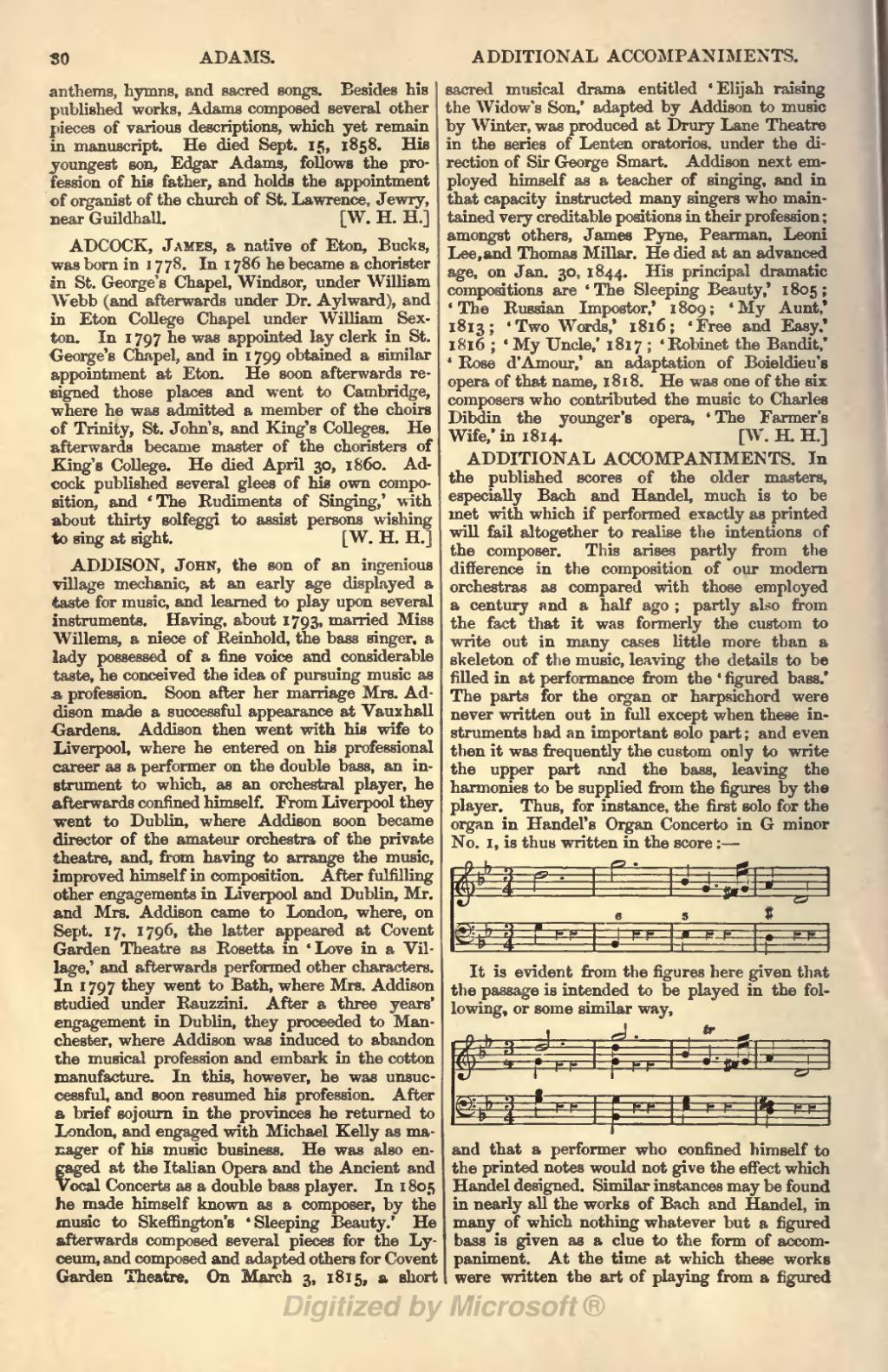anthems, hymns, and sacred songs. Besides his published works, Adams composed several other pieces of various descriptions, which yet remain in manuscript. He died Sept. 15, 1858. His youngest son, Edgar Adams, follows the profession of his father, and holds the appointment of organist of the church of St. Lawrence, Jewry, near Guildhall.
[ W. H. H. ]
ADCOCK, James, a native of Eton, Bucks, was born in 1778. In 1786 he became a chorister in St. George's Chapel, Windsor, under William Webb (and afterwards under Dr. Aylward), and in Eton College Chapel under William Sexton. In 1797 he was appointed lay clerk in St. George's Chapel, and in 1799 obtained a similar appointment at Eton. He soon afterwards resigned those places and went to Cambridge, where he was admitted a member of the choirs of Trinity, St. John's, and King's Colleges. He afterwards became master of the choristers of King's College. He died April 30, 1860. Adcock published several glees of his own composition, and 'The Rudiments of Singing,' with about thirty solfeggi to assist persons wishing to sing at sight.
[ W. H. H. ]
ADDISON, John, the son of an ingenious village mechanic, at an early age displayed a taste for music, and learned to play upon several instruments. Having, about 1793, married Miss Willems, a niece of Reinhold, the bass singer, a lady possessed of a fine voice and considerable taste, he conceived the idea of pursuing music as a profession. Soon after her marriage Mrs. Addison made a successful appearance at Vauxhall Gardens. Addison then went with his wife to Liverpool, where he entered on his professional career as a performer on the double bass, an instrument to which, as an orchestral player, he afterwards confined himself. From Liverpool they went to Dublin, where Addison soon became director of the amateur orchestra of the private theatre, and, from having to arrange the music, improved himself in composition. After fulfilling other engagements in Liverpool and Dublin, Mr. and Mrs. Addison came to London, where, on Sept. 17, 1796, the latter appeared at Covent Garden Theatre as Rosetta in 'Love in a Village,' and afterwards performed other characters. In 1797 they went to Bath, where Mrs. Addison studied under Rauzzini. After a three years' engagement in Dublin, they proceeded to Manchester, where Addison was induced to abandon the musical profession and embark in the cotton manufacture. In this, however, he was unsuccessful, and soon resumed his profession. After a brief sojourn in the provinces he returned to London, and engaged with Michael Kelly as manager of his music business. He was also engaged at the Italian Opera and the Ancient and Vocal Concerts as a double bass player. In 1805 he made himself known as a composer, by the music to Skeffington's 'Sleeping Beauty.' He afterwards composed several pieces for the Lyceum, and composed and adapted others for Covent Garden Theatre. On March 3, 1815, a short sacred musical drama entitled 'Elijah raising the Widow's Son,' adapted by Addison to music by Winter, was produced at Drury Lane Theatre in the series of Lenten oratorios, under the direction of Sir George Smart. Addison next employed himself as a teacher of singing, and in that capacity instructed many singers who maintained very creditable positions in their profession; amongst others, James Pyne, Pearman, Leoni Lee, and Thomas Millar. He died at an advanced age, on Jan. 30, 1844. His principal dramatic compositions are 'The Sleeping Beauty,' 1805; 'The Russian Impostor,' 1809; 'My Aunt,' 1813; 'Two Words,' 1816; 'Free and Easy,' 1816; 'My Uncle,' 1817; 'Robinet the Bandit,' 'Rose d' Amour,' an adaptation of Boieldieu's opera of that name, 1818. He was one of the six composers who contributed the music to Charles Dibdin the younger's opera, 'The Farmer's Wife,' in 1814.
[ W. H. H. ]
ADDITIONAL ACCOMPANIMENTS. In the published scores of the older masters, especially Bach and Handel, much is to be met with which if performed exactly as printed will fail altogether to realise the intentions of the composer. This arises partly from the difference in the composition of our modern orchestras as compared with those employed a century and a half ago; partly also from the fact that it was formerly the custom to write out in many cases little more than a skeleton of the music, leaving the details to be filled in at performance from the 'figured bass.' The parts for the organ or harpsichord were never written out in full except when these instruments had an important solo part; and even then it was frequently the custom only to write the upper part and the bass, leaving the harmonies to be supplied from the figures by the player. Thus, for instance, the first solo for the organ in Handel's Organ Concerto in G minor No. 1, is thus written in the score:—

It is evident from the figures here given that the passage is intended to be played in the following, or some similar way,

and that a performer who confined himself to the printed notes would not give the effect which Handel designed. Similar instances may be found in nearly all the works of Bach and Handel, in many of which nothing whatever but a figured bass is given as a clue to the form of accompaniment. At the time at which these works were written the art of playing from a figured

